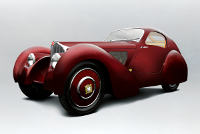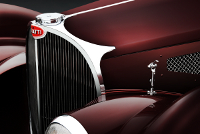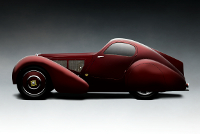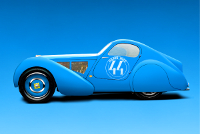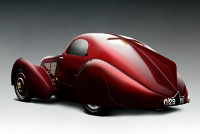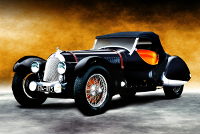Location:
Pebble Beach Concours d'Elegance, 2009
Owner: Helen & Jack Nethercutt | Sylmar, California
Prologue:
Image 4 depicts chassis #51133 as painted upon delivery from Louis Dubos in 1937, and as driven in the Paris-Nice Rally later that year. This photo uses a slightly different perspective than Photo 3, which is a true profile. I was very fortunate to photograph this Bugatti, even the few shots I managed. The car lives in the Nethercutt Collection in Sylmar, California, so public appearances only come around on the occasion of something like celebrating Bugatti at the Pebble Beach Concours d'Elegance. I wish I could show more about how the coachwork has been fitted over the Type 51 Grand Prix platform, and that amazing interior, but just the opportunity to spend a few quiet minutes around the car as it sat in the winners circle proved valuable. We can now add to our portfolio an absolutely unique, and no-less outrageous Bugatti.
- - - - - - - - - -
► Image Source 1-5: Nikon D200 (10.2 MP)
References:
- Hemmings Motor News: "Dana Point's Winning 1931 Bugatti Type 51" by David Traver Adolphus, July 1, 2011. A great read, with lots of historic photographs.
- UltimateCarPage: As usual, a go-to source for images, information, and technical details. Work by Wouter Melissen, October 14, 2009.
- The Globe and Mail: "If This Bugatti Could Talk" by Bob English, July 13, 2011.
Chassis #51133 began life in the hands of the Bugatti factory racing team, being that the Type 51 is at heart a grand prix car. A twin-cam update of the Type 35, this supercharged straight-8 cylinder car could top 140 miles per hour in racing guise. But the tale of #51133 isn't so serious as it is vexing. At the close of the '31 season the car was given to factory driver Louis Chiron—namesake of the modern incarnation's latest hypercar—possibly in lieu of wages. Chiron then campaigned #51133 privately but sold it in 1932, whence Paul Morand and René Dreyfus were named among drivers for the new owner. The Bugatti turned up a new owner almost every year until 1936, when one André Bith took possession following the death of whichever number owner had at that time unfortunately perished in the Deauville Grand Prix while driving a Maserati 8CM.
Monsieur Bith was 26 and had inherited a fortune. Let us not be too wrapped up in the how and why of his bon vivant lifestyle, (mostly because that part is less convenient to research and less important for this profile), and just say he raced and rallied #51133, but gradually changed its character from that of a pure racer to a road-worthy sports car. In a year or more, Bith added cycle fenders, larger headlamps, and a spare tyre kit. He also cut out a passenger door to accommodate guests alongside, namely ladies.
Bith was also a friend of Jean Bugatti, and had been fascinated by the sweeping Atlantic Electron Coupe Jean devised for the Type 57. He was also of a mind to drive his car in colder seasons, and so conceived of a baby Atlantic body for his Type 51. Bith's friend, André Rolland, sketched the design and approximated the proportions, then Bith engaged Carrossier Louis Dubos to complete the coachwork. The coachwork took 14 weeks to deliver and was finished on July 20, 1937, and it remains the lone example of its kind.
Bith kept the Bugatti for only a short time. Now less suited for racing than for gallivanting about, the car's official exploits were limited. He entered the Paris to Nice rally in '37, and his then-girlfriend and then-Miss France, Jacqueline Ganet, entered the car at the Bagatelle Concours d'Elegance, winning her class and placing second overall. And so after a brief jaunt into rallying and the social scene, Monsieur Bith sold #51133 the following year, in 1938.
An American aviator kept the car during the War, and in 1946 sold the car on to racing driver Maurice Trintignant, who'd purchased it for spares. Trintingant salvaged what he could use and sold the car onward.
In the post-War era, #51133 came to the United States where the Dubos coachwork was removed. Little is known of the chassis' history in this time, up until 1959 when it was purchased by J.B. Nethercutt of California as a rolling chassis. Nethercutt then fashioned a new grand prix body for the car. Meanwhile, the Dubos coachwork survived independently, being fitted to a series of different chassis. Its history in this timeframe is also hazy, but the coachwork eventually wound up with Bob Sutherland of Colorado, a former Bugatti club president, who fitted it to a reproduction chassis. Neither Nethercutt nor Sutherland knew of the missing half to his car.
After Sutherland's death in 1999, the reproduction Bugatti with Dubos coachwork went to auction in 2000. Nethercutt and his staff had only just discovered that his chassis was in fact the original claimant of the Dubos coachwork, and when it appeared at auction Nethercutt was naturally excited to make the acquisition.
Remarkably, when chassis and coachwork were reunited, Monsieur Bith was still alive—then 91 years old—and provided guidance prior to its restoration. Shortly after, chassis and coachwork were reunited after being separated for 50 years, and the fragmented pieces of a fantastic history were all put into place.
Motor: 2,261 cc straight 8-cylinder, cast-iron block and head | 60 mm x 100 mm | 7.5:1 compression
Valvetrain: dual overhead cam, 2 valves per cylinder
Aspiration: single Zenith carburetor, Roots-type supercharger
Power: 185 bhp @ 5,500 rpm
Drivetrain: 4-speed manual gearbox, rear-wheel drive
Front Suspension: solid axle with semi-elliptic leaf springs and friction dampers
Rear Suspension: solid axle with reversed quarter-elliptic leaf springs and friction dampers
Architecture: steel ladder-frame chassis with duralumin and steel coachwork by Carrossier Louis Dubos
Wheelbase: 2,400 mm (94.5 inches)
Etymology:
Bugatti numbering follows sequential factory projects, regardless of the purpose for which each car was built. Thus the Type 51 grand prix car is the rightful successor to the Type 35 grand prix car, which had debuted seven years earlier in 1924. This chassis, #51133, is an original factory race car that was rebodied in 1937 by Dubos.
Figures:
Bugatti built about 40 Type 51 grand prix cars, almost all of which wear open-wheeled or cycle-fendered racing bodies. Chassis #51133 is unique in its aerodynamic coupe configuration.
In Profile: Streamlining a Baby Atlantic Electron Coupe
Image 3 provides perhaps the best representation of how radical the shape is. Sharp linear features define the center of the plan, where the trailing edge of the bonnet side vents, the trailing bonnet seam, the door seams, and the windscreen all align with one another. But then the drastic taper of the tail, the sweeping fenders, the closed-in rear skirts, and that wild dorsal fin diminish the design's linear components, creating an almost egglike shell around an ostensibly straight chassis.
The faired-in headlamps and smooth soffits that cut a deep channel in front of the grille copy the Atlantic Electron Coupe, most notably chassis #57591, the black car owned today by Ralph Lauren. The outline of the door also mimics the Atlantic, and arguably the tail is inspired by the same shape, substituting the Atlantic's riveted dorsal plates for an excuse to extrude a sharp fin off the back of the car. But here the result is something from the aerodynamic school of Paul Jaray resembling the fanciful French coupes that raced at Le Mans. Comparable to the Bugatti's size, small sporting coupes from Fiat also come to mind. Later, in the post-War era, Cisitalia will follow suit.
Chassis Overcoat: The Type 51 Dubos Conversion
What we can't see in this set—my apologies—is that the body sits overtop the original grand prix car in almost perfunctory style. The original curved Grand Prix bulkhead and dashboard still form the head of the cockpit, with narrow sills filling the space between. Because the Type 51 Grand Prix uses the old Type 35's externally mounted brake lever, this equipment lives within that right-side sill area in this converted sports car. So seating remains just as close and cozy as in the Grand Prix car, excepting that the cabin is finished in tan leather with sycamore trim. Mixed with the turned aluminum dash and metal hardware, it's a remarkable space both in the way it seems to have been dropped overtop an old racer, then dressed up to the nines.
Paris-Nice: Illustrating the Type 51 Dubos Period Rally Version
I enjoy depicting past variations of famous cars, looking for opportunities to expand sets with an impression of what these historic figures would look like today. In 1937, this Bugatti was delivered from Louis Dubos in Monsieur André Bith's choice of French racing blue. The internet provided a photo of the car on the Paris-Nice Rally that same year, which you can see here in this story posted by Hemmings, and that gave me enough direction to attempt a modern-day impression.
Color Stories: History of Bugatti Chassis #51133 Presentation
Prior to its rebody, Bith painted his Type 51 black and clothed the interior in white leather. As depicted in image 4, the car was received from Carrossier Louis Dubos in French racing blue, now with a tan interior. Bith's then girlfriend, Jacqueline Ganet suggested a deeper shade of blue, and took chassis #51133 to the Bagatelle Concours wearing what Hemmings describes as South Seas Blue. Subsequent owners painted the car black and white. Skipping forward, upon restoration in 2003 the car emerged in black, but was later changed to a stunning burgundy metallic, proving that choice of paint always comes down to the taste of the owner.
Last Updated: Mar 26, 2025

